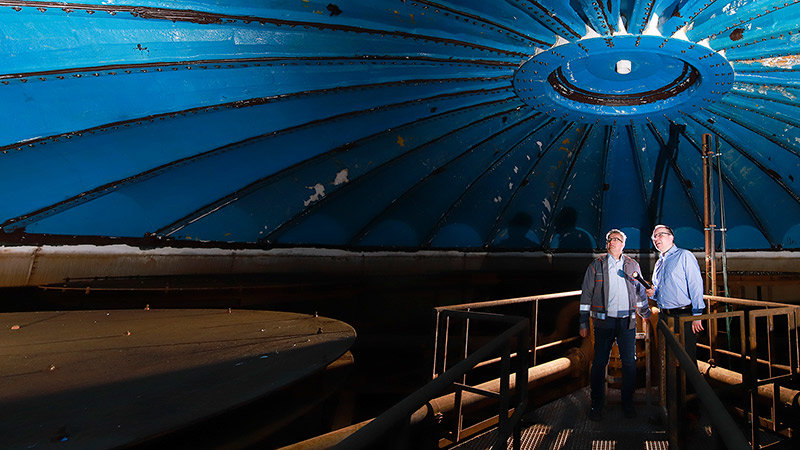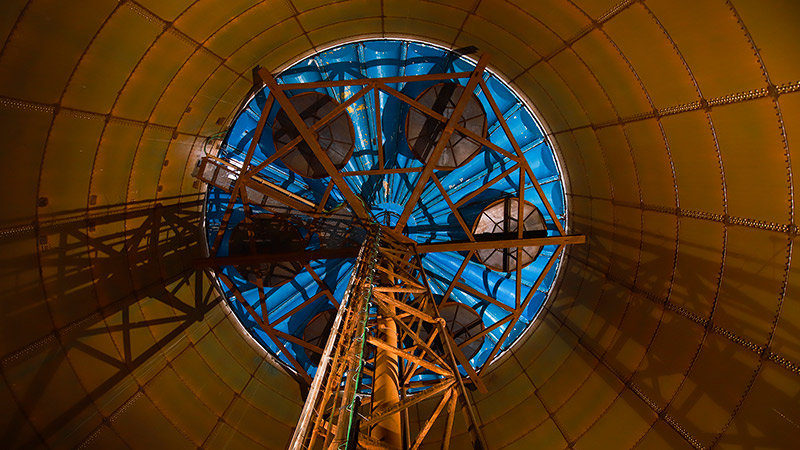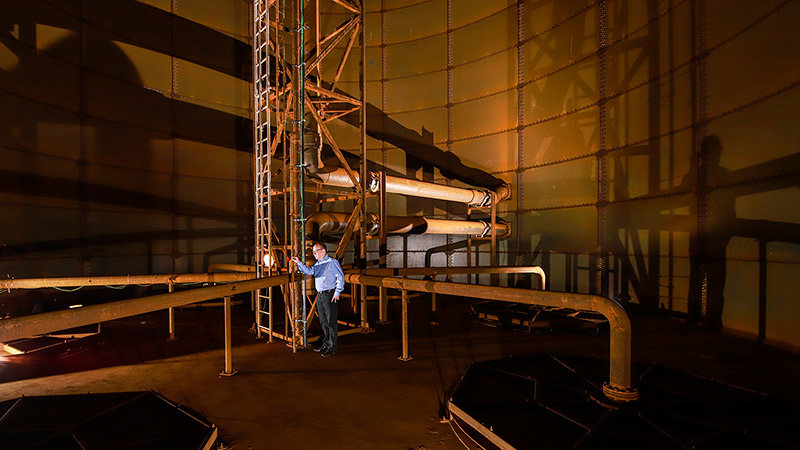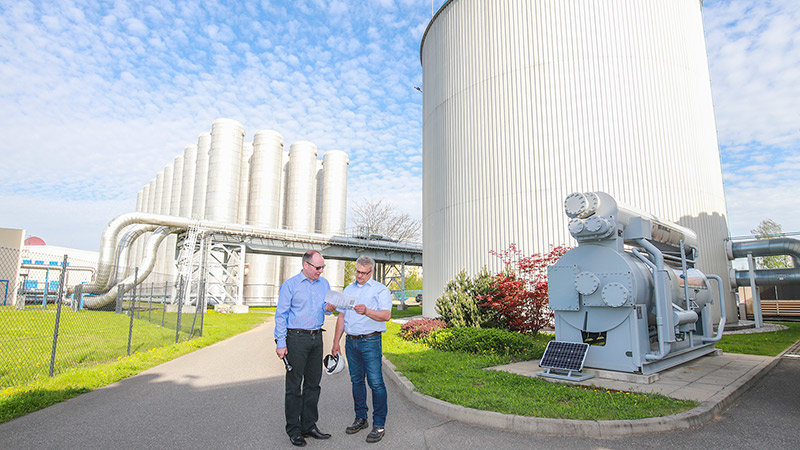“Made in Chemnitz” Cold Water Storage Celebrates Continued Success
Chemnitz University’s large-scale cold water storage research receives positive feedback – results from a technical inspection of Germany’s first short-term cold water storage tank are optimistic
-

Prof. Dr. Thorsten Urbaneck (right), Head of the Thermal Energy Storage Group of the Professorship of Technical Thermodynamics, and Ulf Uhlig, Department Manager at inetz GmbH in Chemnitz, assess the condition of the store from inside the upper area of the storage tank. Photo: Jacob Müller -

An unusual view of the storage tank’s filling and discharge system which is installed at a height of approximately 17 meters. This space is usually filled with approximately 3,500 cubic meters of cold water. Photo: Jacob Müller -

Prof. Dr. Thorsten Urbaneck, Head of the Thermal Energy Storage Group of the Professorship of Technical Thermodynamics, examines the temperature measuring lance in the center of the cold water tank. Photo: Jacob Müller -

Prof. Dr. Thorsten Urbaneck (left) and Ulf Uhlig discuss a list of the sensors installed inside the water storage tank. Photo: Jacob Müller
In summer, temperatures in Germany can reach almost 40 degrees Celsius. Many people try to beat the heat by spending their time in air conditioned buildings. The air conditioning systems used in these spaces rely more and more on cold water storage tanks in order to cool the air. The city of Chemnitz is a pioneer in the application of this technology. Built in 1973, one of the oldest district cooling systems in Europe can be found here. In addition, near the Georgbrücke, a large-scale short-term cold water storage tank has been in operation since 2007. This store contains approximately 3,500 cubic meters of cold water. Various businesses and institutions in the city draw upon this supply via a 4.5-kilometer long system of piping to run their air conditioning systems – including the opera house, museums, shopping centers and the university. Prof. Dr. Thorsten Urbaneck, Head of the Thermal Energy Storage Group of the Professorship of Technical Thermodynamics, was responsible for designing the large-scale cold storage system in cooperation with Stadtwerke Chemnitz AG (today: eins energie in Sachsen GmbH und Co. KG and inetz GmbH).
After eleven years in operation, the water was recently completely drained from the tank in order to inspect and perform maintenance on many components of the store, including the joints connecting the segments, the pipework and the measurement equipment. “After eleven years, all systems are fully operational and the interior of the storage tank is in really good condition,” says Urbaneck enthusiastically. Ulf Uhlig, Department Manager at inetz GmbH, adds: “We are very satisfied with the tank’s construction and the interior structural framework as well as the filling and discharging system. Now we know that the construction will last for decades to come and we can continue to use the advantages of this store for district cooling systems without restrictions.”
“The store decouples the cold water generation from its consumption in air conditioning systems,” explains Urbaneck. The well-insulated cold water storage tank is filled overnight via the absorption cooling units and thus can meet the needs of consumers in the network during the day. In this way, the cooling system can react very quickly to fluctuations in demand. “Overall we can say that the entire system solution – the interplay between consumers and the storage system, so to speak – works very well. In particular, the difficult problem of water stratification is well resolved,” summarizes Urbaneck. In order to implement additional improvements, the Professorship of Technical Thermodynamics conducts ongoing research and development projects: “We aim to improve the cold water storage system’s functioning, ensure its long-term durability and reduce the costs in construction as well as optimal operation,” says Urbaneck.
“The type of cold water storage developed in Chemnitz has established itself nationwide much faster than was expected. This is due to rising energy prices, which have forced more and more companies to conserve resources,” describes Urbaneck. In the last few years, additional cold storage systems were constructed across Germany that are influenced by Chemnitz University expertise. “We were involved in twelve projects. Next year, as part these projects alone, more than 26,000 cubic meters of cold water will be used in cold water tanks,“ reports the researcher. One relatively new development includes building-integrated cold water storage tanks. Urbaneck explains: “In industrial cooling systems, it is no problem at all to construct a tank reservoir 20 meters in diameter and 20 meters tall, for instance. However, for a posh institute building or clinic, there are usually vastly different ideas about how to design the surrounding area. In that case, we can conceal the reservoir within the building.” The projects cover storage tanks between 500 and 1,500 cubic meters in size. Building-integrated tanks make planning and design more difficult because of the various additional factors to be considered.
“For me, cold water storage is a key technology with which we can bring together ecological goals and economic demand. Because there is still so much to do, since around ten percent of all electricity in Germany is used for cooling, I intend to continue to dedicate myself to further improving cold water storage technology and publishing our progress,” says Urbaneck in conclusion.
More information about research conducted by the Professorship of Technical Thermodynamics: https://www.tu-chemnitz.de/mb/TechnThDyn/
Contact: Prof. Dr. Thorsten Urbaneck, Professorship of Technical Thermodynamics, Tel.: +49 371 531-32463, E-mail: thorsten.urbaneck@mb.tu-chemnitz.de.
Mario Steinebach
11.06.2018




